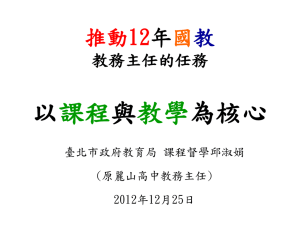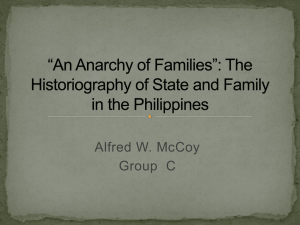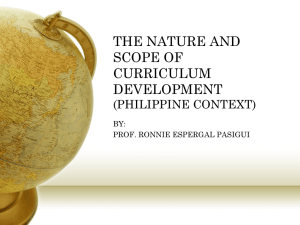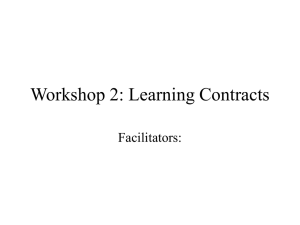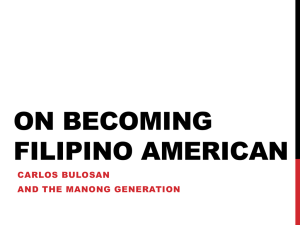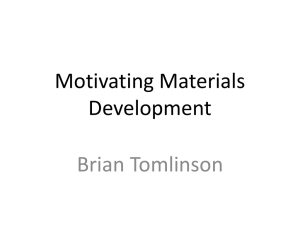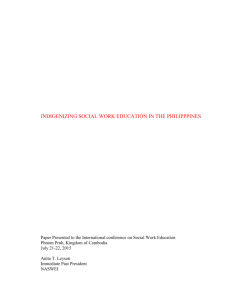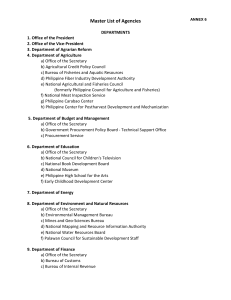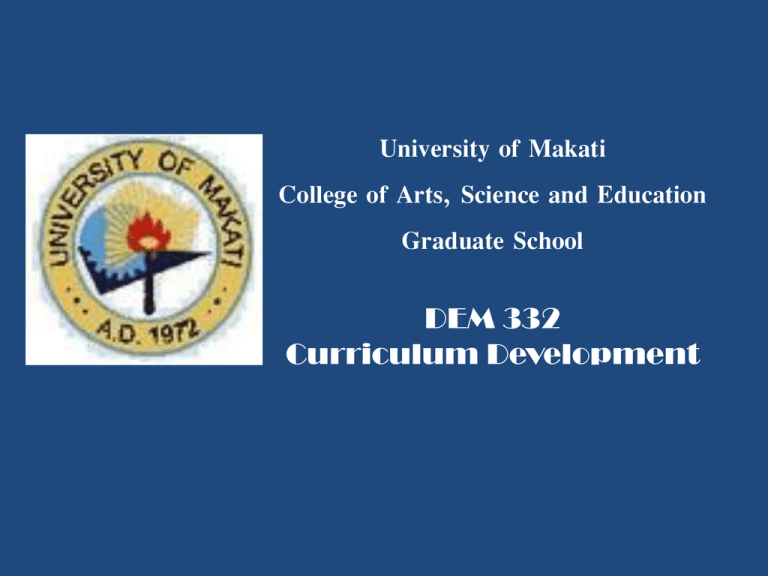
University of Makati
College of Arts, Science and Education
Graduate School
DEM 332
Curriculum Development
THE NATURE AND SCOPE OF
CURRICULUM DEVELOPMENT
(PHILIPPINE CONTEXT)
RYAN C. DE UNA
DepEd Makati City
What is Curriculum Development?
•
•
It is defined as the process of selecting,
organizing, executing, and evaluating learning
experiences on the basis of the needs, abilities
and interests of the learners and the nature of the
society or community.
Refers to the sum of learning stated as
educational ends, educational activities, school
subjects and / or topics decided upon and
provided within the framework of an educational
institution
The Subsystems of Curriculum
• The Formal Curriculum – refers to the school
philosophy, aims and objectives, subjects, an
activities
• The Extra class or Curriculum Extension – which
includes curricular activities like various student
organizations, school newspaper, programs, school
services including library, guidance center, health
clinic, canteen, etc
• The Hidden Curriculum – consists of policies, rules,
and regulations, the school climate
TWO SCHOOLS OF THOUGHT
PREDOMINATED THROUGHOUT THE
HISTORY OF CURRICULUM
DEVELOPMENT;
• The Essentialist School
• The Progressive School
The essentialist school
• It considers the curriculum as something
rigid consisting of discipline subjects.
• It considers all learners as much as the same
and it aims to fit the learner into the existing
social order and thereby maintain the status
quo.,
• Its major motivation is discipline and
considers freedom as an outcome and not
means of education.
The essentialist school
• Its approach is authoritative and the teacher’s
role is to assign lessons and recite recitations.
• It is book-centered and the methods
recommended are memory work, mastery of
facts and skills, and development of abstract
intelligence.
• It has no interest in social action and life
activities.
• Its measurement of outcomes is standard tests
based on subject matter mastery
The progressive school
• It conceives of the curriculum as something
flexible based on areas of interest.
• It is learner-centered, having in mind that no
two persons are alike.
• Its factor of motivation is individual
achievement believing that persons are
naturally good.
• The role of the teacher is to stimulate direct
learning process.
The progressive school
• It uses a life experience approach to fit the
student for future social action.
• Constant revision of aims and experimental
techniques of learning and teaching are
imperative in curriculum development in order
to create independent thinking, initiative, selfreliance, individuality, self-expression and
activity in the learner.
• Its measurements outcome is now devices
taking into consideration subject matter and
personality values.
PHILOSOPHICAL-PSYCHOLOGICAL
ORIENTATION OF CURRICULUM
• Behavioral – Empiricist School : emphasizes the attainment of
learning through the control of variables external to the
individual
• Humanist – phenomenological School: emphasizes the
importance of the individual’s uniqueness and freedom of
choice including the freedom to become and to actualize his
potentialities
• According to humanists; “Authentic education is not carried
by “A” for “B”, or by “A” about “B”, but rather by “A” with “B”
mediated by the world which impresses and challenges both
parties, giving rise to views or opinions about it
Curriculum Approach
Ralph Tyler Model: Four Basic Principle
• Purposes of the school
• Educational experiences related to the
purpose
• Organization of the experiences
• Evaluation of the experiences
Hilda Taba : Grassroots Approach
• Diagnosis of learners needs and expectations
of the larger society.
• Formulation of learning objectives.
• Selection of the learning content.
• Organization of learning content.
• Selection of the learning experiences.
• Organization of learning activities.
• Determination of what to evaluate and the
means of doing it.
Steps in Curriculum Development
• Tyler’s Questions of Curriculum Development will
provide 4 steps:
• What educational purposes should the school seek
to attain?
• What educational experiences can be provided that
are likely to attain these purposes?
• How can these educational experiences be
effectively organized?
• How can we determine whether these purposes are
being attained?
Curriculum Development
• Some curriculum experts like Tyler say that the
steps are followed in a sequence or a straight
line.
• This model that assumes that curriculum
decision making follows a straight line is called
linear model
Curriculum Development
1
2
3
4
• Selection of Aims
• Selection of Content & Learning Experiences
• Organization of content & Learning Experiences
• Evaluation of Learning outcomes
Curriculum Development
• Other scholars argue that curriculum decision
making is not a simple linear process that
necessarily starts with aims.
• One of them is Wheeler (1978) who believes
that curriculum decision making can start
from any point and can come back to any of
the points e.g. like a cycle
Curriculum Development
Aims, Goals &
Objectives
Evaluation
Organisation & Integration of
Learning Experiences & Content
Selection of Learning
Experiences
Selection of Content
Curriculum Development
• Kerr (1968) also believes that curriculum
process is a very complex set of activities and
decisions and they interact a lot.
• Changes made in content may necessitate
changes in experiences, which may again bring
about changes in evaluation etc.
Curriculum Development
Objective
Evaluation
Content
Learning Experience
Selection of Aims and Objectives
• Every curriculum is aimed at developing in the
learners certain competencies or abilities. The
curriculum process must therefore clearly
identify the aims that the curriculum is
intended to achieve.
Selection of Aims and Objectives
• Curriculum aims range from the very broad to the
more specific. In fact, that is why we use the terms
aims, goals and objectives to refer to them. Aims
are broad statements which cover all of the
experiences provided in the curriculum; goals are
tied to specific subjects or group of contents within
the curriculum; while objectives describe the more
specific outcomes that can be attained as a result of
lessons or instruction delivered at the classroom.
Factors in Selecting Aims
• Analysis of our culture
• The present status of the learner
• The state of our knowledge of the subject
matter or content
• Relevance to school’s philosophy of education
• Consistency with our theory of learning
Selection of learning experiences
• Cumulation: even though experiences
provided may be different, they should all lead
to the attainment of the same goal;
subsequent experiences should build on
earlier ones;
• Multiple Learning: a single learning experience
may bring about multiple outcomes. Such
learning experiences are important because of
their multiple benefits.
Factors in Selecting Content
•
•
•
•
•
Validity
Significance
Utility
Interest
Learnability
CURRICULUM IN THE PHILIPPINES
Curriculum in the Philippines
• Touched on the religion, economic, political, and
social influences and events that took place in the
country.
• Colonial rules in the Philippines tailored the
curriculum to serve colonial goals and objectives.
• In the Philippines, the government through its
education agencies, namely: DepEd, CHED, and
TESDA, exercises close monitoring and supervision
of the curriculums of schools at all educational
levels
The Need for Curriculum Framework
• What learning objectives should be included?
• What will be the bases for the choice of
objectives?
• Will the choice be based on the learners’
needs and interests, or rather on the needs of
the society?
• Will the selection depend on tradition, the
nature of knowledge, or the learners’
characteristics?
The Need for Curriculum Framework
• What philosophical and psychological theories
regarding the nature of learners as well as the
learning process will underpin the
organization of the content?
• Will the choice of methodology be in line with
accepted teaching-learning principles?
• Will the evaluation procedure be able to
measure the learning that is taking place?
The result of lack of Framework
•
•
•
•
•
•
•
•
•
•
Sari-sari (hodgepodge)
Pira-piraso (piecemal)
Tagpi-tagpi (patchwork)
Sabog (lack of focus)
Malabo (vague)
Lakas ng kutob (gutfeel)
Hula-hula (hunches)
Gaya-gaya (patterned from an existing model)
Bahala na (by chance)
Patama-tama (non-deliberate)
The Areas of Concern
• Cultural Values
• Knowledge of Learner
• Knowledge Of Teaching-Learning Theories and
Principles
• Body of Knowledge
HISTORICAL CONTEXT
• Before 1521 – Education before the coming of the
Spaniards
• 1521-1896 –Education during the Spanish Regime
• 1896 -1898 – Education during Philippine
Revolution
• 1899 – 1935 – Education during the American
Occupation
• 1935 – 1941 – Education during the Philippine
Commonwealth
HISTORICAL CONTEXT
• 1941 – 1944 – Education during the Japanese
Occupation
• 1945 – 1946 – Education after WWII
• 1946 – present – Education under the
Philippine Republic
Curriculum Development
in the Philippines
The Pre-Spanish Curriculum
• The Filipinos possessed a culture of
their own.
• They had contacts with other foreign
peoples from Arabia, India, China,
Indo-China and Borneo.
The Pre-Spanish Curriculum
• “The inhabitants were a civilized people,
possessing their systems of writing, laws
and moral standards in a well-organized
system of government.
• As shown in the rule of the barangay,
their code of laws-the Code of Kalantiao
and Maragtas-their belief in the Bathala,
and the solidarity of the family were
obedience and respect had been
practiced.
The Spanish-devised Curriculum
• The Spanish missionaries aim to control of the
Filipinos, body and soul. The curriculum then
consisted of the three R’s- reading, writing and
religion to attain goals were the acceptance of
Catholicism and the acceptance of Spanish
rule.
• The schools were parochial or convent
schools. The main reading materials were the
cartilla, the caton and the catecismo. The
method of instructions was mainly individual
memorization.
The Curriculum During the
Commonwealth
• The period of the Commonwealth (1935-1946)
may be considered as the period of expansion
and reform in the Philippine curriculum.
• The educational leaders expanded the curriculum
by introducing course in farming, domestic
science, etc.
• Commonwealth Act 586, also known as
Educational Act of 1940, reorganized the
elementary school system. This measured
ushered the beginning of the decline of the
efficiency of elementary education
The Japanese-devised Curriculum
• They devised the curriculum for the Filipino to
suit their vested interest.
• They introduced many changes in the curriculum
by including Nippongo and abolishing English as a
medium of instruction and as a subject.
• All textbooks were censored and revised. It
causes a blackout in Philippines education and
impeded the educational progress of the Filipinos
The Liberation Period
• In 1945, during the liberation period, steps
were taken to improve the curriculum existing
before the war. Some steps taken were to
restore Grade VII, to abolish the double-single
session and most especially, to adopt the
modern trends in education taken from the
United States.
• The school curriculum remained basically the
same as before and was still subject-centered.
The Curriculum During the Philippine
Republic
• Great experiments in the community school
idea and the use vernacular in the first two
grades of the primary schools as the medium
of instruction were some of them.
• An experiment worth mentioning that led to
a change in the Philippine educational
philosophy was that of school and community
collaboration pioneered by Jose V. Aguilar.
The Curriculum During the Philippine
Republic
• It is a source of gratification also to note that
our schools are increasingly using instructional
materials that are Philippine-oriented.
• This policy been formulated by our
educational leaders, the most recent example
of which being Department Memorandum No.
30, 1966.
The Curriculum During the Philippine
Republic
• This particular memorandum sets the order of
priority in the purchase of books for use in our
schools as follows:
a. Books which are contributions to
Philippine Literature.
b. Books on character education and other
library materials.
c. Library equipment and permanent
features.
Curriculum Approaches
•
•
•
•
•
•
•
•
•
1. Technical – Scientific Approaches
2. Behavioral-rational Approach
3. System-managerial Approach
4. Intellectual –Academic Approach
5. Non-Technician / Non-Scientific Approach
6. Humanistic – aesthetic Approach
7. Re-conceptualist Approach
8. Reconstructionism
9. Eclectic Models
Curriculum Design
•
•
•
•
•
•
The Subject-Area Design
The Integrated Design
The Core-Curriculum Design
The Child-Centered Design
The Social Reconstruction Design
The De-schooling Design
DEFINITION OF EVALUATION
• Curriculum evaluation is a systematic process
of determining whether the curriculum as
designed and implemented has produced or is
producing the intended and desired results.
• It is the means of determining whether the
program is meeting its goals, that is whether
the measures / outcomes for a given set of
instructional inputs match the intended or
pre-specified outcomes. (Tuckman, 1979)
Types of Evaluation
• Humanistic approach – goal free
• Scientific approach – purpose driven
Evaluation Studies in the Philippines
• 1925 Monroe Survey
• 1959 Swanson Survey
• 1969 Presidential Commission to Survey Philippine
Education (PCSPE)
• 1976 Survey of Outcomes of Elementary Education
(SOUTELE)
• 1982 Household and School Matching Survey
• 1991 Congressional Commission on Education
(EDCOM)
• 1991 National Evaluation and Impact Study of
PRODED
CURRENT TRENDS AND ISSUES
BILINGUAL EDUCATION
• Article 14, sect 7 of 1987 constitution – “for the
purposes of communication and instruction, the
official languages of the Philippines are Filipino and
until otherwise provided by law, English.”
• DECS Order 52, s. 1987 – the policy of bilingual
education aims to make every Filipino competent in
both Filipino and English at the national level
• DECS defines bilingual as “separate use of Filipino
and English as media of instruction in specific
subjects.”
Early Childhood Care and Development (ECCD)
• Art 15, Sec 2, 1987 Phil. Cons. – recognizes the
“right of children to assistance, including proper
care and nutrition, and special protection from all
forms of neglect, abuse, cruelty, exploitation and
other conditions prejudicial to their development.”
• UN Convention on the Rights of Child
• Education for All (EFA) agenda of DECS, 1990
envisioned 90% in 2000 of early childhood care and
development either home-based services or
kindergarten / nursery classes
Corricular Redirection in The New
Society
• “To guarantee that the educational system
would be relevant and responsive to the
challenges and requirements of national,
provincial and local development.”
• President Ferdinand Marcos pursuant to
Proclamation No. 1081 issued last Sept. 29,
1972, Decree No. 6 known as the Educational
Development Decree of 1972, to take effect
immediately.
Corricular Redirection in The New
Society
• To advance its objectives, the Educational
Development Decree has formulated a ten-year
program based on a number of principle, among
them: improvement of curricular programs and
quality of instruction at all levels by upgrading
physical facilities; adopting cost-saving instructional
technology and training and retaining of teachers
and administrators; upgrading of academic
standards through accreditation schemes,
admissions testing and guidance counseling; and
democratization of access to education by financial
assistance to poor but deserving students, skills
training programs for out of school youth and a
continuing educational program for illiterate adults.
Corricular Redirection in The New
Society
• The emphasis of the New Society is on
moral values, relevance, proper methods
of teaching, retraining of teachers,
vocational and technical education,
bilingualism, national consciousness and
cultural values.
Corricular Redirection in
the New Society
1. Should be redirected on development of moral virtues
2. As a means of integrating education and life
3. Should reflect the urgent need and problems facing the
country today
4. Should be viewed in terms of learning to be acquired
5. All teaching shall seek to develop comprehensive
under- standing of all subjects
6. Co-curricular youth programs shall be restructured and
enriched
7. Non-formal education shall be recognized
•
•
•
•
•
•
•
•
Other issues
K+12 Curriculum
Access to pre-school education
Private Pre-school education
Global education
Environmental education
UBD- Understanding by design
OBE-Outcome based education
Sex Education



